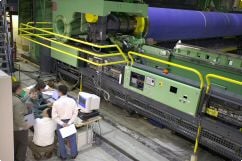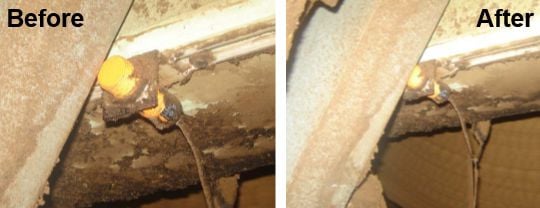Reel service case study - Faulty turnups and mechanical audit
Jul 26, 2022

Issue #1 - Reel creeping
The machine had been running a tape turnup system. The unit had been repaired the previous week. When the tape turnup system failed, the mill was forced to perform manual bag blow turnups. Similar to a tape turnup, the operator opens an air valve that blows the sheet over the new reel spool. When the air is turned off, the sheet should fold over into the new spool. Problems were encountered when the ejected reel crept back toward the reel drum after the initial kickout. This caused the sheet to break and resulted in lost production.
The secondary arms were moving slowly when ejecting the full reel. The backside kicker arms did not keep up with the ejecting reel. The reel began to move away from the drum when the secondary arm loading blocks moved away from the bearing housings. The reel pushed away from the reel drum due to the nip load being relieved. The problem developed when the reel wanted to wander back toward the reel drum. This was due to tension pulling on the reel and drag in the spool bearings that tended to push the reel toward the drum.
Resolution - Hydraulic and automation tuning
Mill personnel adjusted the hydraulic flow control valve to the cap end of the secondary arm cylinders. This increased the eject speed to the brake position, ending missed turnups. However, increasing the flow to the cylinders had a side effect – the full reel would eject to the receiving arms faster than normal, bumping them harder than normal. The flow control valve was reduced to balance the eject speeds.
On a previous visit, Valmet personnel had discussed having two eject speeds for the secondary arms, depending on the position of the arms. (There was already an angle encoder on the secondary arm pivot pin located on the drive side arm.) While doing some checking into the PLC logic at the Valmet office, it was found that such logic already existed in the program. It was just a matter of finding the correct settings... or so they thought.
Unfortunately, the existing logic was not working properly, so they could not adjust the eject speeds. During eject mode, the outputs to the proportional valves would track to zero. Without backpressure, they could not slow the eject speed. At this point the problem became an automation issue.
Valmet’s automation engineer was called in. He modified and fine-tuned the logic until they were satisfied with the eject speed results. When the brake came off, the expiring reel would be guided to the receiving rails in a controlled manner. (Before reprogramming, it would hold the spool back and then release it quickly.) A few manual turnups verified the eject speeds.
Issue #2 - Brake not stopping the spinning reel
A side effect of speeding up the secondary arm eject to the brake station was that sometimes the brake would not stop the spinning reel. When this happened, the reel was ejected and had to be stopped by the receiving arms. This would cause sparks, wear on the arms, and create a mess.
Resolution - PLC logic changes to correctly use prox switch
Using the mill’s Sigma process trending system, the reason was identified. Whenever there was a blip on the brake station proximity switch, the brakes would not stop the reel. Field verification confirmed looseness in the secondary arms when reaching the brake station. The brake movement itself would cause the secondary arm to bounce off the prox switch, which was barely covered by the arm when it stopped (see photo below). The smallest arm movement would move it off the switch. Checking the code logic, the prox switch was the latch permissive for the brake to engage. As soon as the prox dropped out, the secondary arms would kick out 3.5 seconds later – not enough time to stop the reel from spinning.
A timer was added that would seal in the prox switch for 10 seconds. Then, in order to reduce the frequency of use, a second timer was added that allowed the arms to eject further to completely cover the prox switch. The second timer was set to 0.5 seconds and allowed the secondary arm to totally cover the prox switch.

Brake station proximity switch, before and after timing change
Reel process and condition test
Valmet recommended a reel process and condition test for this customer as well. The objective of the reel process and condition test is to define the current condition of the reel and to determine the service operations needed for the next scheduled shutdown or the scope of the reconditioning needs. Another intent is to identify any deficiencies in the reel equipment or the reel building process that may be causing efficiency or quality issues. Hydraulic pressures are analyzed to make sure they’re all controlling properly and compared to other Valmet applications. Valmet experts have performed many such tests, and have assisted many mills in resolving their reeling problems.
Additional recommendation
When trending the secondary arm pressures, it was noted that the tending side pressure was oscillating approximately 45 psi. Sometimes it would only oscillate for a short time as the reel built; other times through the entire reel. The Valmet engineer suspected this valve was probably dirty and should be changed out on a future machine outage. The new valve should be calibrated 0-10 V = 0-175 Bar according to the hydraulic schematics. The drive side pressure control was rock solid.
For assistance with maintaining and improving the operation of your reel, contact your Valmet representative.